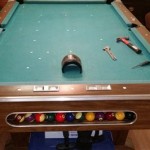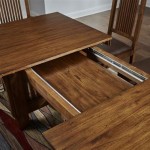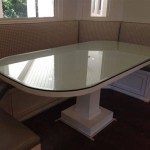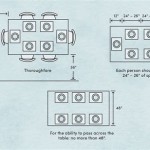Dining Room Tables Made Out Of Doors: A Unique and Sustainable Option
The concept of repurposing materials for furniture creation has gained significant traction in recent years, driven by a growing awareness of environmental sustainability and a desire for unique, character-rich pieces. Among the various upcycling trends, the use of reclaimed doors to construct dining room tables stands out as a particularly compelling option. These tables not only offer a distinctive aesthetic but also contribute to reducing waste and conserving resources. A dining room table made from a door is a conversation starter, a testament to ingenuity, and a functional piece of furniture all rolled into one.
The appeal of a door-turned-dining table extends beyond its eco-friendly nature. Each door carries its own history, visible in the grain of the wood, the remnants of old paint, and perhaps even the marks of hardware that once held it in place. This inherent character adds a layer of depth and personality that is often lacking in mass-produced furniture. Furthermore, the inherent size and structure of a door often lends itself well to creating a substantial and sturdy dining table.
The process of transforming a door into a dining table involves careful planning, skilled craftsmanship, and a touch of creativity. While the basic concept is straightforward, the execution requires attention to detail to ensure both aesthetic appeal and structural integrity. The following sections will delve into the various aspects of creating and selecting a dining room table fashioned from a reclaimed door.
Materials and Preparation
The foundation of any successful door-turned-dining table lies in the selection of the appropriate door. Not all doors are created equal, and several factors should be considered when choosing a suitable candidate for repurposing. The type of wood, the dimensions, the existing hardware, and the overall condition of the door all play critical roles in the final outcome.
Solid wood doors are generally preferred for their durability and aesthetic appeal. Doors made from hardwoods such as oak, maple, or walnut are particularly desirable due to their strength and attractive grain patterns. Softwood doors, such as those made from pine, can also be used, but they may require additional reinforcement to ensure structural stability. The thickness of the door is also a consideration, as a thicker door will naturally provide a more substantial and robust tabletop surface. Doors with intricate carvings or raised panels can add a unique decorative element, while simpler, flat-panel doors offer a more minimalist aesthetic.
Before any modifications are made, the door must be thoroughly cleaned and inspected. All existing hardware, such as doorknobs, hinges, and strike plates, should be removed. Any loose or damaged paint should be scraped away, and the surface should be sanded to create a smooth and even base. Depending on the desired finish, the door may be stripped of all existing paint and varnish, or the existing finish can be left intact to preserve its vintage character. If the door is significantly damaged or warped, it may require repairs before it can be used as a tabletop. This may involve filling cracks, patching holes, or straightening any warped sections.
Once the door has been cleaned and prepared, the next step is to determine the desired dimensions of the finished table. If the door is too large, it can be trimmed to the appropriate size. If it is too small, additional wood can be added to extend the tabletop surface. The edges of the door may also need to be squared off or rounded over, depending on the desired aesthetic.
Safety is paramount when working with reclaimed materials. Old doors may contain lead-based paint or other hazardous substances. It is crucial to wear appropriate safety gear, such as a respirator mask and gloves, when sanding or stripping old paint. Proper ventilation is also essential to minimize exposure to harmful fumes.
Legs and Support Structure
The legs provide the necessary support for the tabletop and determine the overall height and stability of the dining table. There are several options for selecting or creating legs for a door-turned-dining table, each with its own advantages and disadvantages. Pre-made table legs are readily available in a variety of styles and materials, ranging from simple metal legs to ornate turned wood legs. These legs offer convenience and consistency, and they can be easily attached to the tabletop using screws or bolts. However, they may lack the unique character of a custom-made leg.
Custom-made legs can be crafted from wood, metal, or even repurposed materials. Wooden legs can be turned on a lathe or fabricated from dimensional lumber. Metal legs can be welded together from steel tubing or angle iron. Repurposed materials, such as old furniture legs or architectural elements, can also be used to create unique and eye-catching table legs. The method of attaching the legs to the tabletop is crucial for ensuring stability. Wood legs are typically attached using screws and glue, while metal legs may be welded or bolted to a metal frame that is attached to the underside of the tabletop. Regardless of the chosen method, it is important to use high-quality hardware and to ensure that the legs are securely fastened to the tabletop.
In addition to the legs, a support structure may be necessary to provide additional stability and prevent the tabletop from sagging. This is particularly important for larger tables or tables made from thinner doors. The support structure typically consists of a frame made from wood or metal that is attached to the underside of the tabletop. The frame helps to distribute the weight evenly and prevents the tabletop from flexing under load. The design of the support structure will depend on the size and weight of the tabletop, as well as the desired aesthetic.
The height of the dining table is another important consideration. Standard dining tables are typically 28 to 30 inches tall. However, the ideal height may vary depending on the height of the chairs that will be used with the table. It is important to measure the height of the chairs and to adjust the height of the table legs accordingly to ensure comfortable seating.
Finishing and Sealing
The final step in creating a door-turned-dining table is to apply a finish that protects the wood and enhances its natural beauty. The choice of finish will depend on the desired aesthetic, the type of wood, and the intended use of the table. There are a variety of finishes available, each with its own advantages and disadvantages.
Polyurethane is a popular choice for dining tables due to its durability and water resistance. It provides a hard, protective coating that is resistant to scratches, stains, and spills. Polyurethane is available in a variety of sheens, from matte to glossy, allowing for a range of aesthetic options. However, polyurethane can be difficult to apply smoothly, and it may yellow over time.
Varnish is another durable and water-resistant finish that is often used for dining tables. Varnish is typically applied in multiple thin coats, allowing for a smoother and more even finish than polyurethane. Varnish is also available in a variety of sheens, and it tends to be more resistant to yellowing than polyurethane. However, varnish can be more expensive than polyurethane, and it may require more time and effort to apply.
Oil-based finishes, such as tung oil or linseed oil, penetrate the wood and enhance its natural grain and color. Oil-based finishes are relatively easy to apply, and they provide a warm, natural look. However, oil-based finishes are less durable and water-resistant than polyurethane or varnish, and they may require more frequent maintenance.
Water-based finishes are a more environmentally friendly option than solvent-based finishes. Water-based finishes are low in VOCs (volatile organic compounds), which makes them safer to use and less harmful to the environment. Water-based finishes are available in a variety of sheens, and they are relatively easy to apply. However, water-based finishes may not be as durable as solvent-based finishes, and they may require more coats to achieve the desired level of protection.
Regardless of the chosen finish, it is important to prepare the surface properly before applying the finish. The surface should be clean, dry, and free of any dust or debris. The finish should be applied in thin, even coats, following the manufacturer's instructions. Multiple coats may be necessary to achieve the desired level of protection and aesthetic appeal. After the finish has dried completely, the table can be lightly sanded with fine-grit sandpaper to remove any imperfections and create a smooth, even surface.
In addition to the finish, a sealant may be applied to further protect the wood from moisture and stains. Sealants are typically applied after the finish has dried completely. A variety of sealants are available, including wax, polyurethane, and acrylic sealants. The choice of sealant will depend on the type of finish and the intended use of the table.
Dining room tables made out of doors offer a unique blend of sustainability, character, and functionality. By carefully selecting the right door, crafting a sturdy support structure, and applying a protective finish, it is possible to create a stunning and durable dining table that will be enjoyed for years to come.

Making An Old Door Table I Should Be Mopping The Floor

17 Best Ideas About Old Door Tables On Dining Table Room Diy

Making An Old Door Table I Should Be Mopping The Floor

How To Make A Dining Table Out Of Old Door Furniture Refurbishment Refurbi Diy Tables

Making An Old Door Table I Should Be Mopping The Floor

Diy Learn How To Make A Colorful Dining Table Using Recycled Door

Antique Door Table Mr Vallarta S

Upcycle Your Old Door Create A Diy Table

Diy Door Dining Table American Farmhouse Style

Awesome Table Made Out Of A Repurposed Door In Ivy League Style Dining Room On Extreme Makeover Lodge De Rustic House Glass
Related Posts








